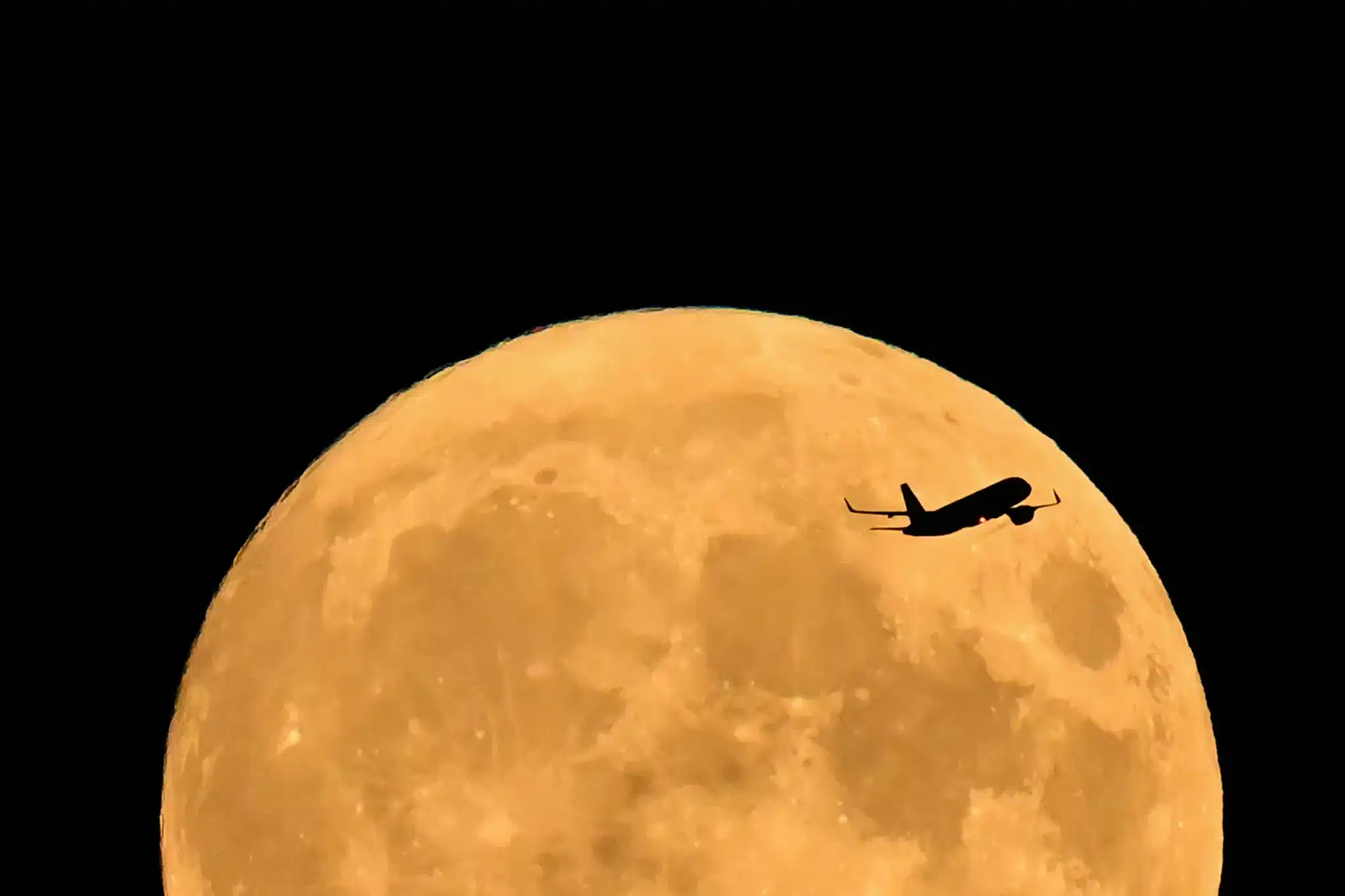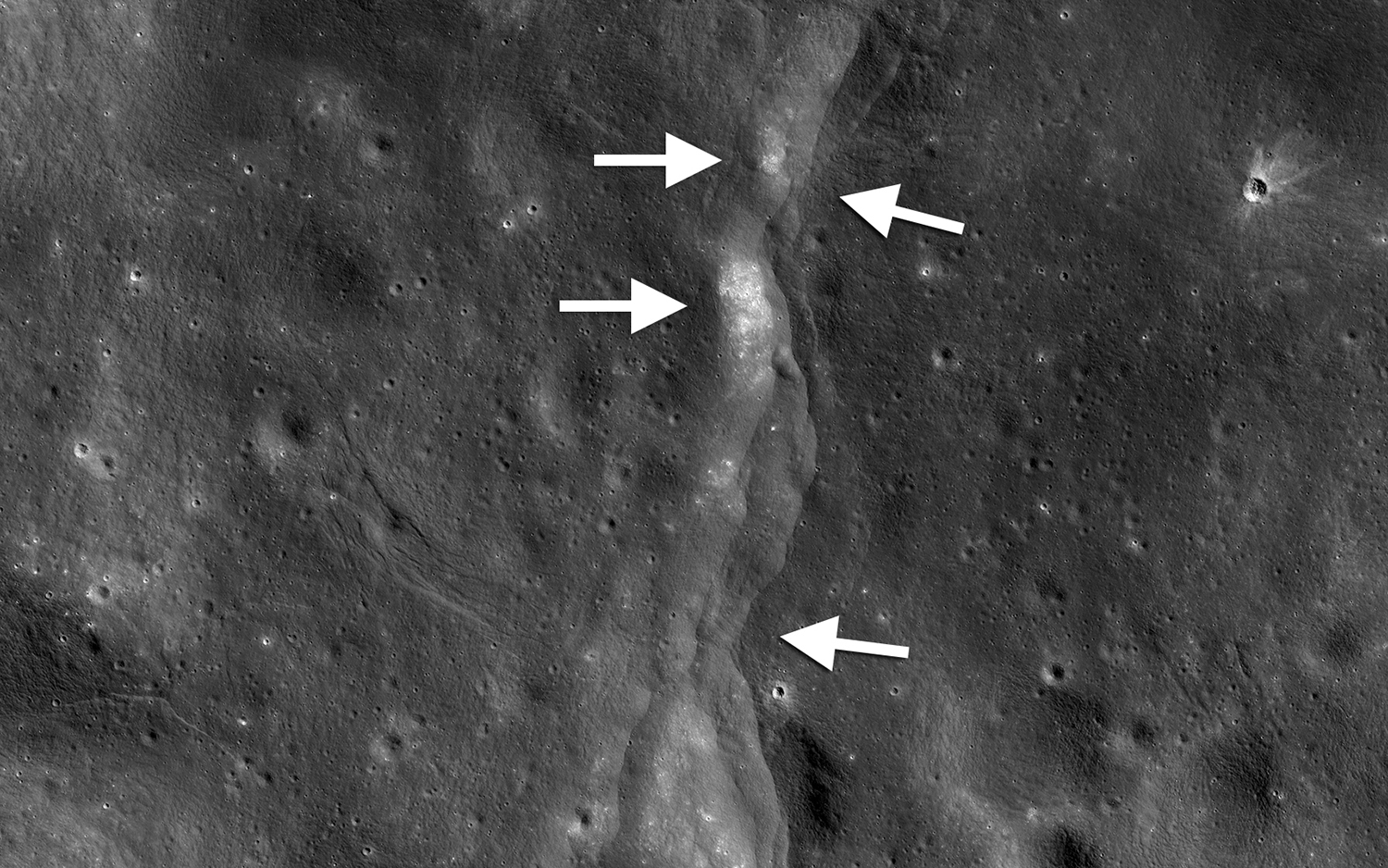Science
Earth’s Moon Is Shrinking. Here’s What Scientists Say That Could Mean

According to a new study, a moon region at the centre of a new worldwide space race due to the possibility of water ice may be less habitable than previously thought.
Interest in the lunar south pole peaked last year when India’s Chandrayaan-3 mission performed the first successful soft landing in the region, just days after Russia’s Luna-25 spacecraft crashed while attempting the same feat. NASA has chosen the region as the landing location for its Artemis III mission, which could send men to the Moon as early as 2026, and China has ambitions to build future habitats there.
However, a NASA-funded study is now raising the alarm: As the Moon’s core gradually cools and shrinks, its surface develops creases, similar to a grape shrivelling into a raisin, resulting in “moonquakes” that can continue for hours and landslides. Much like the rest of the natural satellite’s surface, the area near the south pole that has sparked so much curiosity is prone to seismic disturbances, which could endanger future human residents and equipment.
Earth’s Moon Is Shrinking. Here’s What Scientists Say That Could Mean
“This is not to alarm anyone and certainly not to discourage exploration of that part of the south pole of the moon,” said the study’s lead author, Thomas R. Watters, a senior scientist emeritus in the National Air and Space Museum’s Centre for Earth and Planetary Studies, “but to raise the caution that the moon is not this benign place where nothing is happening.”
Identifying the source of moonquakes
According to researchers, the Moon’s circumference has shrunk by about 150 feet over the previous few million years, a significant amount in geological terms but insufficient to affect Earth or tidal cycles.
However, on the lunar surface, the situation is much different. Despite its appearance, the Moon contains a hot interior that causes seismic activity.
“There is an outer core that’s molten and is cooling off,” Watters told reporters. “As it cools, the moon shrinks, the interior volume changes and the crust has to adjust to that change — it’s a global contraction, to which tidal forces on the Earth also contribute.”
Because the Moon’s surface is brittle, this pushing causes cracks, which geologists call faults. “The moon is thought of as being this geologically dead object where nothing has happened for billions of years, but that couldn’t be more far from the truth,” he said. “These faults are extremely young, and things are happening. We’ve spotted landslides that occurred while the Lunar Reconnaissance Orbiter was in orbit around the Moon.”
Earth’s Moon Is Shrinking. Here’s What Scientists Say That Could Mean
NASA’s Lunar Reconnaissance Orbiter, or LRO, was launched in 2009 and is surveying the Moon’s surface using a variety of instruments. Watters and his colleagues utilised data obtained by LRO to relate a powerful moonquake observed with instruments left by Apollo astronauts more than 50 years ago to a sequence of faults in the lunar south pole.
“We knew from the Apollo seismic experiment, which were four seismometers that operated for a period of about seven years, that there were these shallow moonquakes, but we didn’t really know what the source was,” he said. “We also knew that the greatest of the shallow moonquakes identified by the Apollo seismometers occurred around the south pole. It kind of turned into a detective story to figure out what the cause was, and it turns out that these young flaws are the best suspects.”
The strongest recorded earthquake had a magnitude of 5.0. That would be considered mild on Earth, but Watters believes the Moon’s reduced gravity would make it feel worse.
“Gravity is significantly stronger on Earth, keeping you stuck to the surface. “On the moon, it’s much smaller, so even a small amount of ground acceleration could knock you off your feet if you’re walking,” he explained. “That shaking can start throwing things around in a low G environment.”
Moonquakes: Short-term and long-term implications
According to research coauthor and NASA planetary scientist Renee Weber, the study’s conclusions will not impact the Artemis III landing area selection process because of the mission’s scale and duration.
Earth’s Moon Is Shrinking. Here’s What Scientists Say That Could Mean
“This is because estimating how often a specific region experiences a moonquake is difficult to do accurately, and like earthquakes, we can’t predict moonquakes,” he said. “Strong shallow moonquakes are infrequent and pose a low risk to short-term missions on the lunar surface.”
She said that NASA has identified 13 Artemis III candidate landing areas near the lunar south pole based on characteristics such as the region’s capacity to land safely, the potential to accomplish science objectives, launch window availability, and terrain, communications, and illumination conditions. Two astronauts will live and work on the lunar surface for approximately one week as part of the mission.
However, Weber stated that for long-term human settlement on the Moon, geographic qualities such as proximity to tectonic features and topography could be considered during the site selection.
Like flashlights on the Moon.
Moonquakes could pose a concern for future manned landing missions, according to Yoshio Nakamura, a professor emeritus of geophysics at the University of Texas at Austin and one of the experts who first examined the data acquired by the Apollo seismic stations.
However, Nakamura, who was not part of the study, argues regarding the cause of the quakes, claiming that Apollo data suggests the phenomenon originates tens of kilometres below the surface.
“We still don’t know what causes shallow moonquakes, but it is not the sliding fault near the surface,” he told reporters. “Regardless of what causes those quakes, it is true that they pose a potential threat to future landing missions, and we need more data about them.”
Regardless of the underlying cause, the potential danger moonquakes pose to astronauts will be limited because, at least shortly, humans will only be on the Moon for short periods, a few days at most, according to Allen Husker, a research professor of geophysics at the California Institute of Technology who was not involved in the study.
“It is highly improbable that a major moonquake will occur while they are present. However, it is useful to know that these seismic sources (which cause the quakes) exist. “They can provide an opportunity to better study the moon, just as earthquakes do on Earth,” Husker added. “By the time there is an actual moon base, we should have a much better idea of the actual seismic hazard with upcoming missions.”
Jeffrey Andrews-Hanna, an associate professor of planetary science at the University of Arizona who wasn’t involved in the study, shares that viewpoint. “Moonquakes are an incredible tool for doing science,” he explained in an email. “They’re like headlights in the lunar interior, illuminating the structure for us to see. Studying moonquakes at the South Pole will reveal more about the moon’s internal structure and current activity.
SOURCE – CNN
Science
NASA Astronauts Will Stay At The Space Station Longer For More Troubleshooting Of Boeing Capsule

Two NASA astronauts will stay longer at the International Space Station as engineers work to resolve issues with Boeing’s new space capsule that arose during the mission.
NASA announced on Friday that the astronauts would not return until ground testing was completed and that they were safe.
“We’re not in a hurry to come home,” said NASA’s commercial crew program manager, Steve Stich.
NASA | AP News Image
NASA Astronauts Will Stay At The Space Station Longer For More Troubleshooting Of Boeing Capsule
Butch Wilmore and Suni Williams, veteran NASA test pilots, launched aboard Boeing’s Starliner spacecraft toward the orbiting laboratory on June 5. Boeing’s first astronaut launch came after years of delays and disappointments.
The test voyage was intended to last about a week, giving Wilmore and Williams adequate time to inspect the capsule while docked at the station. However, issues with the capsule’s propulsion system, which is used to steer the spacecraft, forced NASA and Boeing to postpone the flight home many times while investigating the issue.
They also sought to avoid station astronauts interfering with spacewalks. However, this week’s spacewalk was canceled due to water leaking from an astronaut’s spacesuit. The problem still needs rectification, and the planned spacewalk next week has been postponed.
As Starliner approached the space station a day after launch, last-minute thruster malfunctions nearly ruined the docking. Five of the capsule’s 28 engines failed during docking; only one was restarted.
NASA | AP news Image
NASA Astronauts Will Stay At The Space Station Longer For More Troubleshooting Of Boeing Capsule
When the Starliner launched into orbit, it already had one minor helium leak, and numerous more appeared during the voyage. Helium is utilized to pressurize the fuel for the thruster. Boeing stated that the two issues are not a worry for the return trip.
NASA and Boeing delayed the astronauts’ return because they required extra time to gather information about the thruster problems and leaks while the spacecraft was docked. Both are in the service module, a device attached to the capsule that burns up during reentry.
NASA initially stated that the Starliner might stay docked at the space station for up to 45 days owing to battery limitations. However, according to Stich, in-flight studies have proven that the limit can be expanded.
Officials said they would wait to set a return date while conducting ground tests of capsule thrusters in the New Mexico desert, estimated to take a few weeks. They want to try to duplicate what happened during docking.
“I want to make it very clear that Butch and Suni are not stranded in space,” said Stich, adding that Starliner is designed for up to 210-day missions.
NASA | AP news Image
NASA Astronauts Will Stay At The Space Station Longer For More Troubleshooting Of Boeing Capsule
Stich stated that if the space station experiences an emergency, the astronauts could return to Earth via Starliner.
After the space shuttle fleet terminated, NASA handed astronaut rides to private businesses. Elon Musk’s SpaceX has completed nine taxi flights for NASA since 2020. NASA intends to alternate between SpaceX and Boeing in transporting astronauts to and from the space station.
SOURCE – (AP)
World
Why Mount Rainier Is The US Volcano Keeping Scientists Up At Night

Mount Rainier, Washington’s snowcapped peak that stands 4.3 kilometers (2.7 miles) above sea level, has not had a significant volcanic eruption in the last 1,000 years. More than Hawaii’s exploding lava fields or Yellowstone’s vast supervolcano, Mount Rainier has many US volcanologists concerned.
“Mount Rainier keeps me awake at night because it poses a significant threat to the nearby villages. “Tacoma and South Seattle are built on 100-foot-thick (30.5-meter) ancient mudflows from Mount Rainier eruptions,” said Jess Phoenix, a volcanologist and ambassador for the Union of Concerned Scientists, on an episode of CNN’s “Violent Earth With Liv Schreiber.”

Volcano | CNN Image
Why Mount Rainier Is The US Volcano Keeping Scientists Up At Night
The sleeping giant’s deadly potential does not stem from flaming lava flows, which, in the case of an eruption, are unlikely to spread more than a few miles beyond the boundary of Mount Rainier National Park in the Pacific Northwest. According to the US Geological Survey, most volcanic ash will likely drift downwind to the east, away from populated centers.
Instead, many scientists are concerned about a lahar, a fast-moving slurry of water and volcanic rock formed when ice or snow is rapidly melted by an eruption. Lahars gather debris as they run down valleys and drainage channels.
According to Seth Moran, a research seismologist at USGS Cascades Volcano Observatory in Vancouver, Washington, Mount Rainier’s tall height and ice and snow cover make it resilient to eruptive activity. “Hot stuff … will melt the cold stuff and a lot of water will start coming down,” he explained.
“And there are tens, if not hundreds of thousands of people who live in areas that potentially could be impacted by a large lahar, and it could happen quite quickly.”
A lahar is a rapidly flowing debris flow.
The deadliest lahar in recent memory occurred in November 1985, when Colombia’s Nevado del Ruiz volcano erupted. Just a few hours after the eruption began, a flow of mud, rocks, lava, and freezing water surged over the village of Armero, killing over 23,000 people in minutes.
In an episode of CNN’s “Violent Earth,” Bradley Pitcher, a volcanologist and Columbia University lecturer in Earth and environmental sciences, described a hardened, concrete substance that can be difficult to escape.
Pitcher stated that Mount Rainier had approximately eight times the amount of glaciers and snow Nevado del Ruiz had when it erupted. “There’s the potential to have a much more catastrophic mudflow.”
According to the US Geological Survey’s 2018 threat assessment, Hawaii’s Kīlauea volcano is the most dangerous in the US, which is unsurprising given its proximity to the population and periodic eruptions. Mount St. Helens exploded violently in May 1980 and was voted second most dangerous, followed by Mount Rainier in third.
Lahars are most commonly associated with volcanic eruptions, but landslides and earthquakes can also create them. Moran said geologists have discovered evidence that at least 11 massive lahars from Mount Rainier have reached the surrounding area, known as the Puget Lowlands, over the last 6,000 years.
Scientists have not linked the most recent of these lahars, which occurred approximately 500 years ago, to any volcanic activity. According to analysts, the flow event could have been the result of a huge landslide on the mountain’s west face.
The loose, weak rock remains in that location, and Moran and other volcanologists are particularly concerned about the possibility of a similar, spontaneous landslide-induced lahar.

Volcano | CNN Image
Why Mount Rainier Is The US Volcano Keeping Scientists Up At Night
“We now know that the volcano can do it again. “And then we’re in this world where anything can happen at any time,” Moran explained.
“If it were the same size, it would be 10 minutes to the nearest places where people live and 60 minutes to the nearest significant settlements. “And those are very short time frames,” he added.
A 2022 study considered two worst-case scenarios. In the first scenario, a 260 million cubic meter, 4 meter deep (9.2 billion cubic feet, 13-foot deep) lahar would form on Mount Rainier’s west slope. According to Moran, the debris flow would be equivalent to 104,000 Olympic-size pools and could reach the heavily populated lowlands of Orting, Washington, roughly an hour after an eruption, moving at a rate of 13 feet (4 meters) per second.
According to the simulation, a second “pronounced hazard” area is the Nisqually River Valley, where a major lahar may displace enough water from Alder Lake to allow the 100-meter-tall (330-foot-tall) Alder Dam to spill over.
Mount Rainier’s neighbor, Mount St. Helens, farther south in the Cascade Range, erupted four decades ago, causing a disastrous lahar that did not reach any highly populated regions.
Venus Dergan and her then-boyfriend, Roald Reitan, were trapped in the Mount St. Helens lahar while on a camping vacation and are among the few persons known to have survived being swept up in a debris flow.
“I tried to cling on as we were swept downstream, but the tree bark was scraping. … During an interview for CNN’s “Violent Earth,” she recounted feeling it on her legs and arms.
“At one point, I went under the logs and dirt and accepted that this was the end. I was not going to get out of this, and I was going to die.

Volcano | CNN Image
Why Mount Rainier Is The US Volcano Keeping Scientists Up At Night
Following the explosion of Mount St. Helens, the US Geological Survey established a lahar detection system on Mount Rainier in 1998, which has been modified and expanded since 2017.
About 20 places on the volcano’s slopes and the two paths identified as most at risk of a lahar now have broadband seismometers that send real-time data and additional sensors such as trip wires, infrasound sensors, web cameras, and GPS receivers.
Moran explained that the device is designed to identify both a lahar if the volcano erupts in the future and a lahar caused by a landslide.
Because of the constraints of 1990s technology, the original system had limited bandwidth and power requirements, resulting in data transmission every two minutes.
In March, 45,000 kids from Puyallup, Sumner-Bonney Lake, Orting, White River, and Carbonado, Washington, took part in a lahar evacuation simulation. According to the USGS, this was the first time numerous school districts exercised on the same day, making it the world’s largest lahar drill.
Approximately 13,000 pupils walked up to 3.2 kilometers (2 miles) to specified areas outside of the defined lahar zone, while the remaining schools outside the lahar zone practiced sheltering in place.
Moran stated that the fail-safe components of the Lahar detection system are roughly 45 minutes away from the next significant community; thus, that was the time window within which communities had to work.
“Most of what happens at volcanoes is close by, and that’s why you try to keep people away because things happen fast, but lahars can travel a long way from the volcano and have a big impact.”
SOURCE – (CNN)
World
Tropical Storm Alberto Weakens Over Northeast Mexico After Heavy Rains Killed 3

TAMPICO, MEXICO – Tropical Storm Alberto, the season’s first named storm, weakened Thursday as it headed inland across northeast Mexico after dumping torrential rainfall in areas of the arid region and killing at least three.
The storm swiftly faded over land, and the United States National Hurricane Center reduced it to a tropical depression with maximum sustained winds of 35 mph (55 kmh). Coastal storm watches and warnings in Mexico were withdrawn as Alberto proceeded westward at 18 mph (30 kmh).
However, forecasts predicted several inches of rain were still anticipated inland in Mexico’s Tamaulipas, Nuevo Leon, and Coahuila states. South Texas was expected to experience less rain on Thursday.
Immediately after it came ashore in Tampico, there was disappointment at the lack of rain. Showers had been irregular throughout the early morning, with the sun occasionally bursting through.
Alberto | AP news Image
Tropical Storm Alberto Weakens Over Northeast Mexico After Heavy Rains Killed 3
“We hoped it would come because water is so important here, but as far as I can tell, it went somewhere else,” said Tampico resident Marta Alicia Hernández.
The rain Tampico had hoped for could still be arriving from some of the huge system’s outer bands. Heavy rains were reported inland in the adjacent state of Nuevo Leon.
Civil protection authorities reported three deaths as a result of Alberto’s rains. They said that one guy died in the La Silla River in Monterrey, the state capital, while two kids perished from electric shocks in the municipality of Allende. According to local media, the children were riding bicycles in the rain.
Nuevo Leon Gov. Samuel García said on social media site X that Monterrey metro and public transportation services would be suspended from Wednesday night until midday Thursday when Alberto dies away.
Alberto had prompted tropical storm advisories for most of the western Gulf of Mexico’s coastline, from Texas to Veracruz. The storm landed with maximum sustained winds of 45 mph (75 km/h).
Schools in Tamaulipas state, where Alberto touched ashore, were closed through Friday. Shelters were set up across the state to accommodate residents fleeing flooding.
Alberto | AP news Image
Tropical Storm Alberto Weakens Over Northeast Mexico After Heavy Rains Killed 3
According to the hurricane center, some portions of northeast Mexico and southern Texas could receive up to 5 inches (13 centimeters) to 10 inches (25 centimeters) of rain, with higher isolated totals likely. Some higher elevations in Mexico could experience up to 20 inches (50 cm) of rain, causing mudslides and flash flooding, particularly in the states of Tamaulipas, Coahuila, and Nuevo Leon.
Mexican authorities had minimized Alberto’s risk, instead relying on its potential to alleviate the region’s water shortage.
“The (wind) speeds are not such as to consider it a risk,” said Tamaulipas state Secretary of Hydrological Resources Raúl Quiroga Álvarez during a news conference late Wednesday. Instead, he urged people to welcome Alberto cheerfully. “This is what we’ve been waiting for for eight years in all of Tamaulipas.”
Much of Mexico has suffered from severe drought, with northern Mexico particularly heavily afflicted. Quiroga highlighted that the state’s reservoirs were depleted, and Mexico owed the United States a significant water debt for their shared usage of the Rio Grande.
“This is a win-win event for Tamaulipas,” he told reporters.
Alberto was also causing rain and floods along the Texas coast.
According to the National Weather Service, the major hazard for southern coastal Texas is flooding caused by excessive rain. On Wednesday, the NWS stated that there is “a high probability” of flash flooding in southern coastal Texas. Tornadoes and waterspouts are possible.
Alberto | AP News Image
Tropical Storm Alberto Weakens Over Northeast Mexico After Heavy Rains Killed 3
On Wednesday, areas along the Texas coast experienced road flooding and severe rip currents, while waterspouts were reported offshore.
Octavio González, a Tampico resident, was noticeably disappointed with Alberto’s light rain.
“Very little water fell,” he explained. “We are experiencing severe drought on the south side of Tamaulipas. And the truth is, we have a lot of optimism for rain.”
SOURCE – (AP)
-
World2 weeks ago
Former President Trump Survives Being Shot at Pennsylvania Rally
-
Tech4 weeks ago
Huawei Launches 5G-A Pioneers Program at MWC Shanghai 2024: Paving the Way for a Connected Future
-
Sports4 weeks ago
NBA Draft: Kyle Filipowski Withdraws Unexpectedly From The First Round
-
Tech4 weeks ago
ChatGPT Answers Undiscovered Questions and Outperforms Students.
-
News4 weeks ago
US Supreme Court Rejects Drug Deal that Protects the Sackler Family
-
Health4 weeks ago
US Health Agency Issues Dengue Virus Infection Warning






















